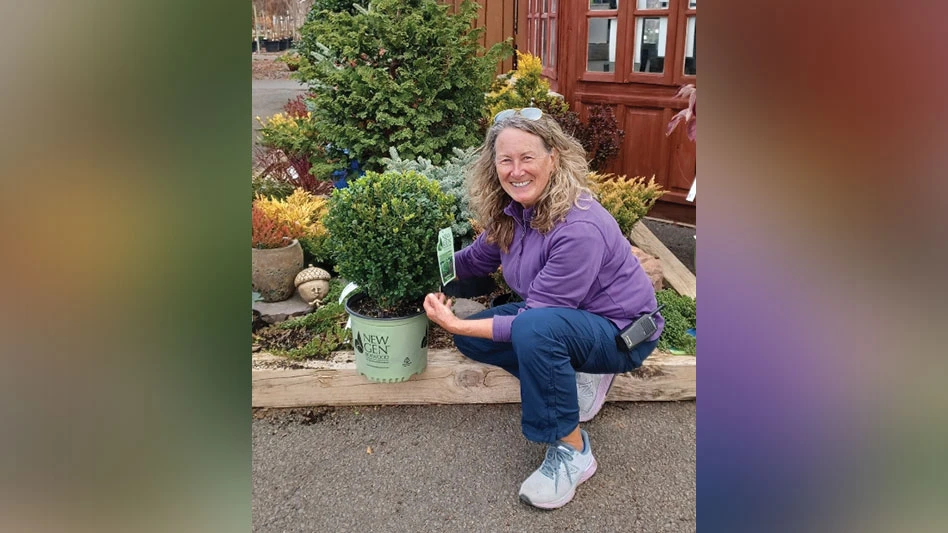

I am always impressed by the marketing programs and information that Diane Blazek, executive director, and her team produce at National Garden Bureau (NGB).
The organization literally gives growers and retailers “news you can use” to market plants and products. You can lift the information as is or shape it to suit your company’s messaging and communications outreach.
Among my favorite programs heading into spring, NGB publishes its annual “Year of Plants.” Six plant categories include species, types and varieties, downloadable presentations, photos, how-tos, history and more.
The 2024 plant classes will include Angelonia (annual), lily (bulb), squash (edible), African violet (houseplant), hosta (perennial) and buddleia (shrub). The current plant classes include celosia (annual), amaryllis (bulb), broccoli (edible), orchid (houseplant), rudbeckia (perennial) and spirea (shrub).
Curious minds want to know the “Year of Plants” backstory, so I caught up with Blazek for a Q&A.

How large is NGB’s membership?
Diane Blazek: We have 159 members ranging from breeders to brokers and growers to retailers. We also have many authors, communicators and podcasters. This is a record number of members in our 103-year history.
When did NGB start the “Year of Plants” program?
DB: Back in 1980, we began with just an annual and an edible. We were the first in the industry to create a “Year of” program. The idea was to bring attention to a plant class that was easy to grow, popular, had many varieties and was an area where breeders were actively trying to improve. That still holds true today.
How have the plant categories changed over the years?
DB: Although the program was consistent for 30 years, it has changed dramatically over the past decade. Part of the reason is that our membership has expanded dramatically as well. Whereas we used to be an organization catering to seed breeders and sellers, we now cover much more of the horticulture market. About 10 years ago, we started considering annuals that were vegetatively propagated for the program. Then we added a perennial category, which then led to a bulb category, then a flowering shrub and now a houseplant category. This is a decision made by our board of directors and based on input from members.
Why are plant categories designed as “umbrellas?”
DB: We wanted more of an all-encompassing “Year of” program so that breeders, growers and retailers can customize it to fit their own product assortment. This way, a much broader audience can take advantage of the program.
Who determines what plants will be included?
DB: Our members determine the “Year of” crops by popular vote. Every three years, we survey our members as to what classes should be featured over the next three years. We provide them with five or six choices, recommended by our board, in each category and the top choices win. While we know the “Year of” crops a few years in advance, we only release that information to our members 11 months in advance, the industry six months in advance and to the public two months in advance.
Are marketing needs of growers considered when determining plant selections?
DB: Very much so! We are not picking crop classes that are difficult to grow or difficult to find, or varieties that are not easy to obtain. These classes are just as easy for the grower to grow and find as they are for the consumer. I’ll give an example for our shrub for 2024, which is the buddleia. We are all aware that the butterfly bush is on the list of invasive species in some states. Part of our mission for 2024 is to educate all points in the chain of distribution, including garden communicators and consumers, that the newer varieties are sterile and are a very good alternative to the older varieties that are considered invasive.

Do consumer trends factor into the selections?
DB: Yes, definitely. For example, if our members are looking at crops to choose from and see some that are not good sellers or just passé, they are not going to vote for that one. We do want to highlight plant classes that are already popular and that the breeders also see as an area of expansion and improvement. In looking at this year’s annual – celosia – we have seen many new and unique varieties brought to the market in recent years, like Dragon’s Breath, the Gekko series, Flamma Orange, Kelos Candela and others. It’s exciting to see how many unique traits breeders are putting into these newer varieties.
Are there requirements in each category that species must meet?
DB: Just that the species must fall into that category. For example, a few years ago our perennial category was Salvia nemorosa and all other salvia perennials. A few members wanted to submit annual salvia, but we had to turn those away since it was not the annual category that we were promoting.
Where do growers fit in determining the species that will be included?
DB: If they are NGB members, they get a vote in the decisions. Since they are customers of breeders and brokers who are members, it’s their purchases that help determine the popularity of each crop class.
Why should growers incorporate the “Year Of” information in their marketing communications initiatives, education programs and client events and activities?
DB: It’s free and easy. When presenting programs for the next year, growers can use this program to bring some excitement to the featured varieties. We have stats that show the sales of those featured plant classes do increase in both the year of promotion as well as the year after. It is a super easy way to take advantage of a national program that will increase sales.
“NGB provides a myriad of marketing tools that can be used by retail and growers alike,” says Denise Mullins, director of product information at Smith Gardens, Bellingham, Wash. “I mainly use the ‘Year of Plants’ to have internal conversations with our sales teams and customers about potentially increasing production on certain crops and programs.”
Blazek says the NGB’s member experts provide the program’s growing information, and its breeder members write the articles.
“National Garden Bureau’s promotions reach a large consumer gardening audience,” she says. “With 103 years under our belts, we have a good reputation among consumers of providing quality, unbiased information.”
For more information about the “Year of” program, visit NGB online at ngb.org.
Get curated news on YOUR industry.
Enter your email to receive our newsletters.
Explore the May 2023 Issue
Check out more from this issue and find your next story to read.
Latest from Nursery Management
- The Growth Industry Episode 3: Across the Pond with Neville Stein
- What's in a name?
- How impending tariffs and USDA layoffs impact the horticulture industry
- Shifting the urban environment
- These companies are utilizing plastic alternatives to reduce horticultural waste
- How to create a sustainable plant nursery
- Lamiastrum galeobdolon ‘Herman’s Pride’
- One of rarest plants on earth: Tahina spectabilis







